Creating a child-friendly home is essential for the development and safety of young ones. From toddlers to teenagers, each age requires specific considerations to ensure their environment is both safe and stimulating. This comprehensive guide covers how to design living spaces that support a child’s growth and creativity while providing peace of mind for parents.
Designing for Safety
1. Childproofing Essentials: Begin with the basics of childproofing by securing furniture to the wall to prevent tipping and using safety gates to control access to dangerous areas. Cover electrical outlets, and ensure that all windows have locks and guards. It’s also crucial to keep hazardous materials, like cleaning supplies and medications, out of reach and securely stored.
2. Safe Play Areas: Dedicate specific areas of your home for play. Ensure these spaces are free from sharp corners and breakable items. Soft flooring materials like foam tiles can cushion falls and provide a safer surface for play.
Fostering Engagement and Creativity
3. Learning Zones: Set up designated areas that encourage learning. Include a variety of age-appropriate books and interactive educational toys that promote problem-solving and creativity. For older children, a well-organized study area with ample lighting can make homework and studying more appealing.
4. Artistic Spaces: Encourage creativity by providing an art corner equipped with non-toxic supplies where children can paint, draw, and craft. Easy-to-clean surfaces and accessible storage solutions will allow children the freedom to express themselves artistically without worry over messes.
Integrating Nature
5. Outdoor Integration: If space allows, create a safe outdoor play area. This could be as simple as a sandbox or as elaborate as a custom-built playset. Outdoor play is crucial for physical health and provides children with the opportunity to explore nature.
6. Indoor Plants: Incorporate plants within your home to teach children about nature and responsibility. Choose non-toxic plants that are safe for children and pets. Engaging children in caring for plants can also foster a sense of responsibility and connection to the living world.
Community and Social Interaction
7. Community Spaces: If you live in a multi-family dwelling or community, take advantage of shared spaces. Many communities have playrooms, pools, and other amenities that provide safe environments for children to socialize and engage with peers.
8. Flexible Living Areas: Create flexible living spaces that can adapt to various activities, from family game nights to sleepovers. Modular furniture and ample storage can help keep the area organized and ready for whatever activity is next.
Designing a child-friendly home involves more than just safety; it’s about creating a nurturing environment that promotes development through play, learning, and social interactions. By taking these steps, parents can provide a space where children feel secure and valued, and where they are free to explore and grow. Each element of a child-friendly home not only ensures the safety of young residents but also plays a crucial role in their physical and cognitive development.






Leave A Comment